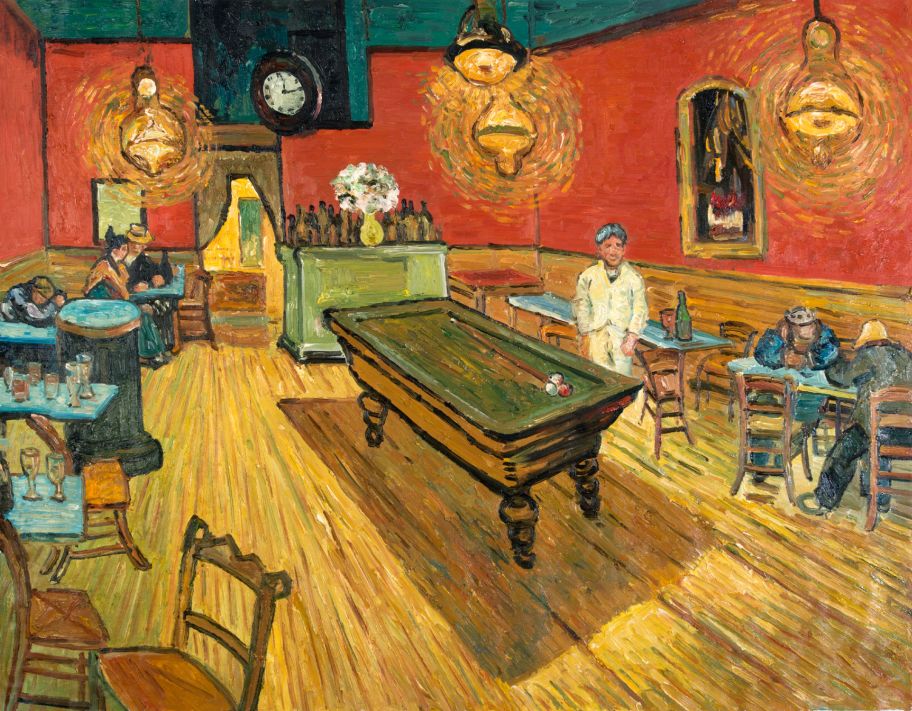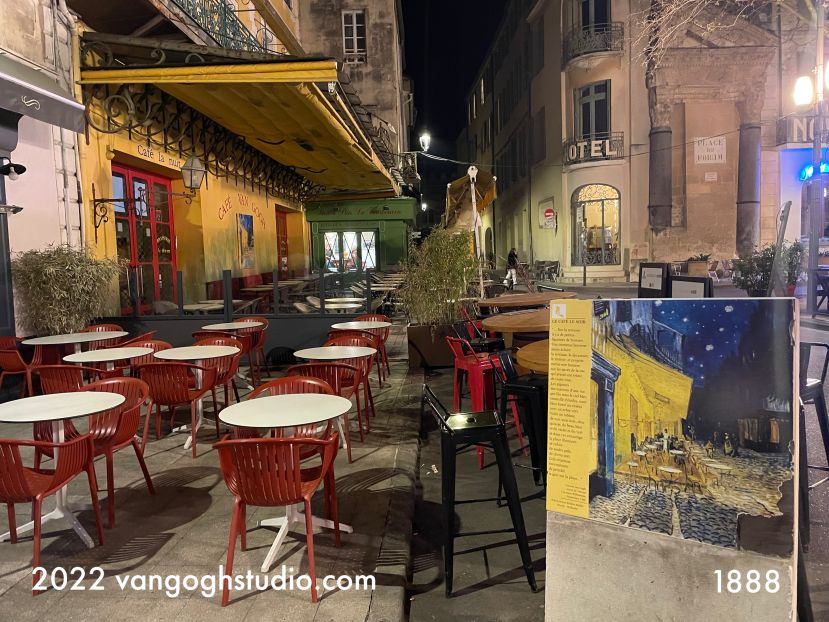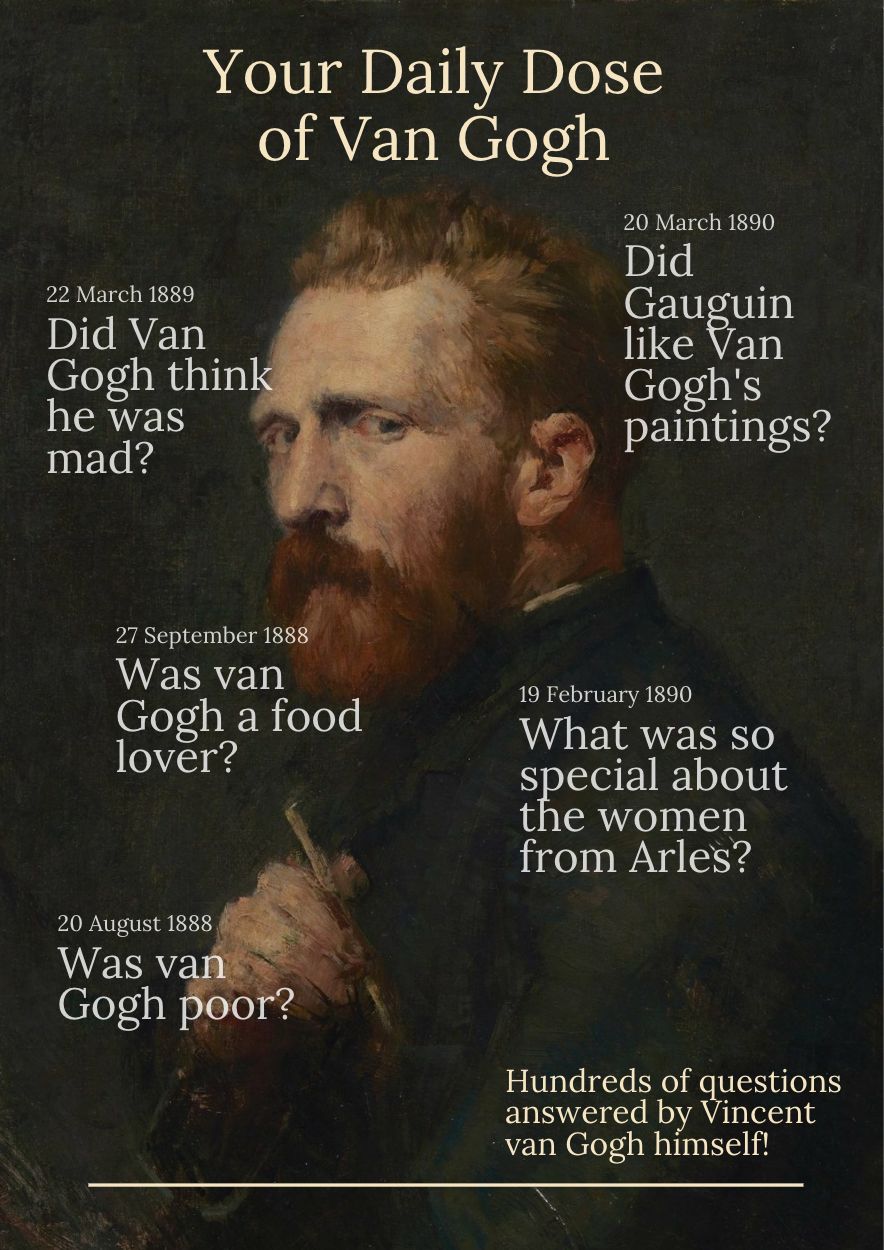-
The Night Cafe by Vincent van Gogh
Van Gogh's The Night Café – Everything You Need to Know
"The Night Café" is one of Vincent van Gogh's most striking interior scenes, painted in September 1888 during his time in Arles, France. This painting captures the atmosphere of a late-night café, a place Van Gogh described as revealing the "terrible passions of humanity." The vivid colors and contrasting lighting emphasize an almost uncomfortable feeling, reflecting Van Gogh's perspective on the darker side of nightlife and human vulnerability.Today, "The Night Café" is part of the collection at the Yale University Art Gallery in New Haven, Connecticut, USA. This museum provides an opportunity for visitors to see firsthand Van Gogh's skillful use of color and perspective to convey emotion. It remains one of the key works showcasing his exploration of intense color as a tool to evoke strong feelings.

Our hand-painted replica of Van Gogh's The Night Café
What inspired Van Gogh to paint The Night Café?
Van Gogh was inspired by his fascination with human experiences, including the darker and more isolating aspects of nightlife. The café was a place where people from all walks of life would come together, yet often felt alone. Van Gogh described the scene in his letters to his brother Theo, emphasizing the uncomfortable reality of such a setting. His intent was to depict a place where people could drown their sorrows, and his use of garish colors—red, green, and yellow—was meant to convey a sense of unease, highlighting the complex emotions experienced by those who frequented such places.How did Van Gogh's personal life influence The Night Café?
During the time Van Gogh painted "The Night Café," he was experiencing feelings of isolation and struggling with his mental health. He spent long nights in cafés, observing the patrons, their interactions, and their solitude. His choice to depict this scene reflected his own state of mind—his struggle with loneliness and his empathetic view of the human condition. Van Gogh was deeply impacted by the harshness of life in Arles, and this painting represents his attempt to expose the hidden despair that can accompany such environments.What techniques did Van Gogh use in The Night Café?
In "The Night Café," Van Gogh used a variety of techniques to convey an unsettling and almost claustrophobic atmosphere. His use of complementary colors—such as the vibrant red walls against the green ceiling—creates a visual tension that mirrors the emotional disquiet of the setting. He also employed heavy outlines and bold brushstrokes to give the objects in the room an exaggerated, almost distorted look. The tilting perspective, with receding lines that draw the viewer into the scene, was deliberately executed to evoke discomfort, as if the viewer were being pulled into a world that is slightly off-balance.What emotions does The Night Café evoke?
"The Night Café" evokes emotions of discomfort, unease, and loneliness. The intense, clashing colors, combined with the vacant expressions of the patrons and the harsh lighting, create a sense of emotional disarray. The almost surreal setting, with its strange angles and vivid palette, reflects the inner turmoil of those gathered there. Van Gogh succeeded in using color not just to represent the physical appearance of the café but to evoke a visceral response from viewers, making them feel the tension and sadness present within.What symbols can be found in The Night Café?
Van Gogh included various symbols in "The Night Café" to convey deeper meanings. The empty chairs scattered across the room suggest loneliness and waiting, while the clock shows a late hour, emphasizing the passage of time in a place that never truly rests. The billiard table, oddly centered in the room, serves as a symbol of emptiness, detached from the people who are present. These details contribute to a narrative of despair and isolation, capturing the hidden emotions that permeate the atmosphere of a late-night gathering spot.How does Van Gogh’s use of color in The Night Café differ from his other works?
Van Gogh’s use of color in "The Night Café" starkly contrasts with the warm, natural tones of his outdoor scenes, such as "The Harvest" or "Café Terrace at Night." Here, the colors are chosen to clash rather than harmonize—reds, greens, and yellows are used in exaggerated, almost unnatural hues to evoke discomfort. While his sunflowers and landscapes often convey a sense of hope and renewal, "The Night Café" creates a much darker, more unsettling mood. This painting marks a deliberate departure from his usual style, using color to express an emotional intensity rather than physical beauty.How did Van Gogh’s surroundings in Arles influence The Night Café?
Van Gogh’s stay in Arles had a significant impact on his depiction of "The Night Café." The café culture in the South of France, with its late-night patrons, was something he observed closely. The Place Lamartine, where the café was located, was a central hub for people seeking solace or distraction. The vibrant but harsh lighting of these night spots, along with the people who frequented them, provided Van Gogh with the inspiration to capture a moment that spoke to the human condition—the intersection of social activity and isolation.What makes The Night Café significant in Van Gogh's body of work?
"The Night Café" is significant because it exemplifies Van Gogh's ability to use color not just for representation but as a powerful emotional tool. He described the painting as an attempt to express "the terrible passions of humanity by means of red and green." It stands out in his body of work as one of his most experimental uses of color and perspective, pushing boundaries to evoke emotion rather than depict reality. This approach laid the groundwork for future movements like Expressionism, which also sought to convey emotional experience through bold colors and forms.Did Van Gogh create other works of the Place Lamartine café?
Yes, Van Gogh painted other works that depicted scenes from the Place Lamartine area. Most notably, he painted "Café Terrace at Night," a contrasting view of the café from the outside. Unlike the oppressive interior of "The Night Café," the terrace scene is bathed in a softer, romantic light, creating a sense of warmth and conviviality. This duality in perspective illustrates Van Gogh's ability to capture both the inviting and the isolating aspects of public spaces, depending on his emotional focus.Own Your Own Hand-Painted Replica of The Night Café
If you’ve been fascinated by the intensity of Van Gogh's The Night Café, you can now bring this unique masterpiece into your home. Our hand-painted replica, crafted in oil on canvas, faithfully captures the vivid colors, dramatic lighting, and emotional tension of Van Gogh’s original. Skilled artists meticulously recreate the disorienting perspective and dynamic brushstrokes, making this iconic painting come alive.Whether you are a dedicated art collector or simply an admirer of Van Gogh’s work, owning a replica of The Night Café allows you to experience the powerful emotions and vibrant energy of this intense painting. Order your hand-painted replica today and add a piece of art history to your space.
Visit Van Gogh's Arles: Experience the Café Life that Inspired His Paintings

The Place du Forum in Arles, where Van Gogh found inspiration for another café painting
Your Daily Dose of Van Gogh
Discover what Vincent van Gogh wrote on this day.Find out in your FREE Van Gogh e-book.
Hundreds of questions answered by Van Gogh himself!
Comments (0)
No comments found.
